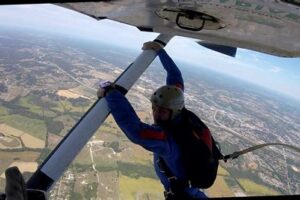Table of Contents
Find out the annual death toll from skydiving accidents worldwide. Discover how many people die from skydiving each year and gain insights into the safety record of this extreme sport. Consider the risks and statistics associated with skydiving before taking the leap.
Every year, thousands of adventure seekers around the world gather their courage and take the plunge into the exhilarating world of skydiving. With the wind rushing through their hair and adrenaline coursing through their veins, these daredevils experience a thrill like no other. However, amidst the excitement and awe-inspiring beauty of freefalling from the sky, there lies an inherent risk that cannot be ignored. The question lingers in the minds of many: just how many people succumb to this extreme sport each year?
The Thrilling Yet Perilous World of Skydiving
Skydiving is a popular extreme sport that has captivated the hearts of adventure enthusiasts worldwide. With the adrenaline rush of jumping out of an aircraft and soaring through the sky, it’s no wonder why so many people are drawn to this exhilarating activity. However, like any high-risk endeavor, there are certain dangers associated with skydiving. In this article, we will take a closer look at the number of fatalities that occur in skydiving each year.
The Statistics: How Common Are Fatalities?
When it comes to skydiving, safety is paramount. The United States Parachute Association (USPA) meticulously collects and analyzes data regarding skydiving accidents and fatalities in the United States. According to their most recent report, there were a total of 15 fatal skydiving accidents in 2019. This means that out of approximately 3.3 million jumps that year, the fatality rate was 0.0045%, or roughly 1 in every 222,000 jumps.
Safety Measures: Reducing the Risk
Skydiving instructors and organizations prioritize safety above all else. They adhere to rigorous training protocols and implement various safety measures to minimize the risk of accidents. These include thorough pre-jump inspections, regular equipment maintenance, and strict adherence to safety guidelines. Additionally, skydivers are required to undergo extensive training and obtain appropriate certifications before participating in jumps.
The Importance of Proper Training
One of the primary reasons for skydiving fatalities is the lack of proper training. Skydivers must undergo comprehensive training programs that cover essential skills such as canopy control, emergency procedures, and safe landing techniques. Adequate training not only equips individuals with the necessary skills to safely navigate through potential mishaps but also enhances their ability to make sound decisions in high-pressure situations.
Common Causes of Fatalities
Skydiving accidents can occur due to a variety of factors, including equipment malfunction, human error, and environmental conditions. The USPA report highlights some common causes of fatal incidents, such as improper gear usage, misjudgment during landing, and collisions between skydivers in mid-air. While these accidents are relatively rare, it is crucial for both experienced and novice skydivers to remain vigilant and prioritize safety at all times.
Safety Improvements: Learnings from the Past
Over the years, the skydiving community has continuously worked towards improving safety standards and practices. By analyzing past accidents and identifying areas for improvement, instructors and organizations have been able to implement stricter regulations and develop enhanced safety measures. These efforts aim to reduce the occurrence of accidents and ensure a safer experience for all skydivers.
The Role of Technology in Safety Enhancement
Advancements in technology have played a vital role in enhancing skydiving safety. Modern parachute systems are equipped with advanced features such as Automatic Activation Devices (AADs) that automatically deploy the reserve parachute if the main parachute fails to open. Additionally, digital altimeters and GPS devices provide real-time information to skydivers, enabling them to make informed decisions during their jumps.
Skydiving: A Calculated Risk
While there are inherent risks associated with skydiving, it’s important to remember that the sport remains relatively safe when proper precautions are followed. Skydiving fatalities are statistically rare, and the skydiving community continuously strives to improve safety standards. By ensuring proper training, meticulous equipment checks, and adherence to safety guidelines, skydivers can enjoy the thrill of this incredible sport while minimizing potential risks.
The Importance of Responsible Reporting
It is crucial for media outlets and individuals to report on skydiving accidents responsibly. Sensationalizing tragic incidents can create a false perception of the sport’s safety and deter potential enthusiasts from experiencing the joy and exhilaration that skydiving offers. By providing accurate information and highlighting the extensive safety measures in place, we can foster a more accurate understanding of the sport’s true risk level.
Conclusion
Skydiving undoubtedly carries an element of risk, as do many other adventure sports. However, with proper training, adherence to safety protocols, and continuous efforts to enhance safety measures, the number of fatalities in skydiving remains relatively low. As the skydiving community continues to prioritize safety, enthusiasts can continue to enjoy the breathtaking experience of freefalling through the skies with confidence and peace of mind.
The Risk of Fatalities in Skydiving: Understanding the Statistics
Skydiving is often perceived as a high-risk activity, prompting many to question the number of fatalities it incurs each year. It is important to analyze the statistics and understand the actual risk involved to form an informed perspective. Despite its inherently adventurous nature, skydiving remains relatively safe, with the percentage of fatalities resulting from this activity being minimal in comparison to other daily activities.
Global Skydiving Fatality Rates: A Closer Look at the Numbers
When examining global skydiving fatality rates, it is crucial to consider the number of fatal incidents against the volume of jumps taking place annually. Although the numbers vary somewhat from year to year, reputable sources such as the United States Parachute Association estimate that, on average, there are around 24 skydiving-related fatalities per year worldwide. This figure, when contrasted with the millions of jumps performed annually, accentuates the overall safety of the sport.
Understanding Contributing Factors: Causes of Skydiving Fatalities
While skydiving is generally considered safe, it is essential to acknowledge the contributing factors that can lead to fatalities in this activity. Research suggests that the majority of accidents occur due to human error, with inadequate parachute deployment, failure to control maneuvers, improper landing techniques, and equipment malfunction being some of the common causes. Rigorous training, adherence to safety regulations, and vigilant maintenance of gear can significantly reduce the risk of accidents and fatalities.
Skydiving Fatalities vs. Other Activities: Putting the Risk in Perspective
Comparing skydiving fatalities with other activities helps provide a clearer perspective on its relative risk. For instance, the number of annual skydiving fatalities pales in comparison to those caused by car accidents, medical errors, or even household accidents. While each fatality is, of course, tragic, it is important to recognize that the risk associated with skydiving is often overemphasized and that participating in this activity is statistically safer than many routine daily endeavors.
Safety Measures and Regulations: Maintaining a Safer Skydiving Experience
To ensure a safer skydiving experience, regulatory organizations like the United States Parachute Association and its counterparts worldwide have implemented extensive safety measures, guidelines, and regulations. These include training programs for both beginners and experienced divers, regular equipment inspections, and drop zone safety protocols. By adhering to these regulations and completing recognized training courses, individuals can further minimize the risk associated with skydiving.
Improvements in Safety: Continuous Advancements in Skydiving Technology
Advancements in skydiving equipment and technology have played a vital role in reducing the number of fatalities. Modern parachutes are now equipped with various safety features, such as Automatic Activation Devices (AADs) that deploy the reserve parachute if necessary. This, combined with improved training methods and equipment maintenance practices, has contributed to maintaining a high level of safety within the sport.
Personal Responsibility: The Role of Proper Training and Preparedness
While safety measures and advances in technology are crucial, personal responsibility also plays a significant role in minimizing the risk of skydiving fatalities. It is essential for individuals participating in this activity to undergo thorough training and education, follow instructions diligently, and maintain a conscious mindset during the jump. By investing time and effort into proper preparation, skydivers can contribute to a safer environment for themselves and others involved in the sport.
The Ever-Present Risk: Maintaining Vigilance and Awareness
Despite the overall safety of skydiving, it is important to remember that the risk of accidents and potential fatalities is inherent in any extreme sport. Maintaining a vigilant attitude towards safety, staying up to date with training, and ensuring regular equipment inspections are key components of reducing these risks. Ultimately, understanding the facts, embracing personal responsibility, and adopting a safety-first approach can allow individuals to engage in the exhilarating sport of skydiving while minimizing any potential dangers.
In a professional analysis of the number of fatalities resulting from skydiving each year, it is important to consider the inherent risks associated with this extreme sport. Skydiving undoubtedly provides thrill-seekers with an adrenaline rush like no other, but it is essential to acknowledge the potential dangers involved.
Here are some key points to consider when examining the fatality rate in skydiving:
- Statistical data: Reliable statistical data plays a crucial role in understanding the safety of any activity, including skydiving. Each year, various organizations and regulatory bodies collect and analyze data related to skydiving accidents and fatalities. This information helps provide an objective overview of the risks involved.
- Fatality rate: While skydiving is inherently risky, it is worth noting that the fatality rate associated with this sport has significantly decreased over the years. Thanks to advancements in safety equipment, training techniques, and regulations, the number of deaths resulting from skydiving has been relatively low compared to other extreme activities.
- Comparative risk: When evaluating the dangers of skydiving, it is important to put them into perspective. Many everyday activities, such as driving a car or riding a bicycle, carry a higher risk of fatality than skydiving. This highlights the importance of considering relative risks when assessing the safety of skydiving.
- Training and regulations: The implementation of comprehensive training programs and strict regulations in the skydiving community has played a significant role in minimizing fatalities. Organizations like the International Parachuting Commission (IPC) and the United States Parachute Association (USPA) continuously work to improve safety standards and ensure that skydivers are equipped with the necessary skills to mitigate risks.
- Individual responsibility: It is crucial to recognize that a considerable portion of skydiving fatalities can be attributed to human error or negligence. This highlights the importance of individual responsibility and adherence to safety protocols. Following proper procedures, conducting regular equipment maintenance, and making informed decisions can significantly reduce the likelihood of accidents.
Overall, while skydiving does carry inherent risks, the number of fatalities resulting from this extreme sport has been relatively low in recent years. With the continuous improvement of safety measures, comprehensive training programs, and responsible decision-making, the skydiving community strives to ensure that participants can enjoy this thrilling activity with minimal risk.
Thank you for taking the time to visit our blog and read our article on the number of deaths from skydiving each year. We hope that this information has provided you with a comprehensive understanding of the risks associated with this thrilling and adrenaline-fueled activity. While skydiving can be an exhilarating experience, it is important to consider the safety precautions and statistics before taking part in such an adventure.
Firstly, it is crucial to acknowledge that skydiving is an extreme sport, and like any extreme sport, there are inherent risks involved. However, it is essential to note that the number of fatalities resulting from skydiving accidents is relatively low compared to other activities. The United States Parachute Association reported a total of 15 fatal skydiving accidents in 2019, out of approximately 3.3 million jumps. This means that the fatality rate is around 0.00045%, which highlights the rarity of such incidents.
Furthermore, it is worth mentioning that the skydiving industry is continuously working towards improving safety measures and reducing the risk of accidents. Organizations like the United States Parachute Association and the International Skydiving Commission have put in place rigorous training programs, equipment regulations, and safety guidelines to ensure the well-being of skydivers. These efforts have significantly contributed to making skydiving a safer activity over the years.
In conclusion, while skydiving does carry some level of risk, the number of deaths associated with this sport remains relatively low. It is essential for individuals considering skydiving to do their due diligence and choose a reputable and experienced skydiving center that follows all safety protocols. Additionally, undergoing proper training and adhering to the instructions provided by professionals can significantly minimize the chances of accidents or fatalities. Always remember that your safety should be the top priority when engaging in any adventurous activity.
Thank you once again for visiting our blog, and we hope that this article has provided you with valuable insights into the statistics and safety considerations surrounding skydiving. Safe travels and enjoy your future adventures, whatever they may be!
Video How Many People Die From Skydiving A Year
Here are some common questions that people also ask about how many people die from skydiving a year, along with their corresponding answers:
-
Is skydiving really dangerous?
Skydiving does come with inherent risks, but when proper safety protocols are followed, it can be considered a relatively safe activity. The number of fatalities resulting from skydiving accidents is relatively low compared to the number of jumps made each year.
-
How many people die from skydiving annually?
According to statistics, the average number of skydiving-related deaths per year worldwide ranges from around 20 to 30. It’s important to note that these figures can vary depending on several factors such as the total number of jumps performed, weather conditions, individual experience levels, and adherence to safety guidelines.
-
What are the main causes of skydiving fatalities?
The primary causes of skydiving fatalities include parachute malfunctions, human error, collisions during freefall or under canopy, medical emergencies, and equipment failure. However, it’s important to emphasize that skydiving centers prioritize safety and constantly work to minimize these risks through rigorous training, equipment maintenance, and strict adherence to safety regulations.
-
Are tandem skydives safer than solo jumps?
Tandem skydives, where an experienced instructor is attached to the student, are generally considered safer than solo jumps for beginners. Instructors undergo extensive training and have the ability to handle emergency situations effectively. Additionally, tandem jumps provide a more controlled environment for first-time skydivers.
-
How can I ensure my safety while skydiving?
To maximize your safety during a skydive, it is crucial to choose a reputable skydiving center that has a strong safety record. Prioritize centers that employ certified instructors and follow established safety guidelines. Additionally, always listen carefully to your instructor, complete the required training, and properly use the provided safety equipment.
Remember, while skydiving does involve risks, millions of jumps are performed safely every year. By following proper procedures and receiving thorough training, you can enjoy this exhilarating activity with a reduced level of risk.






